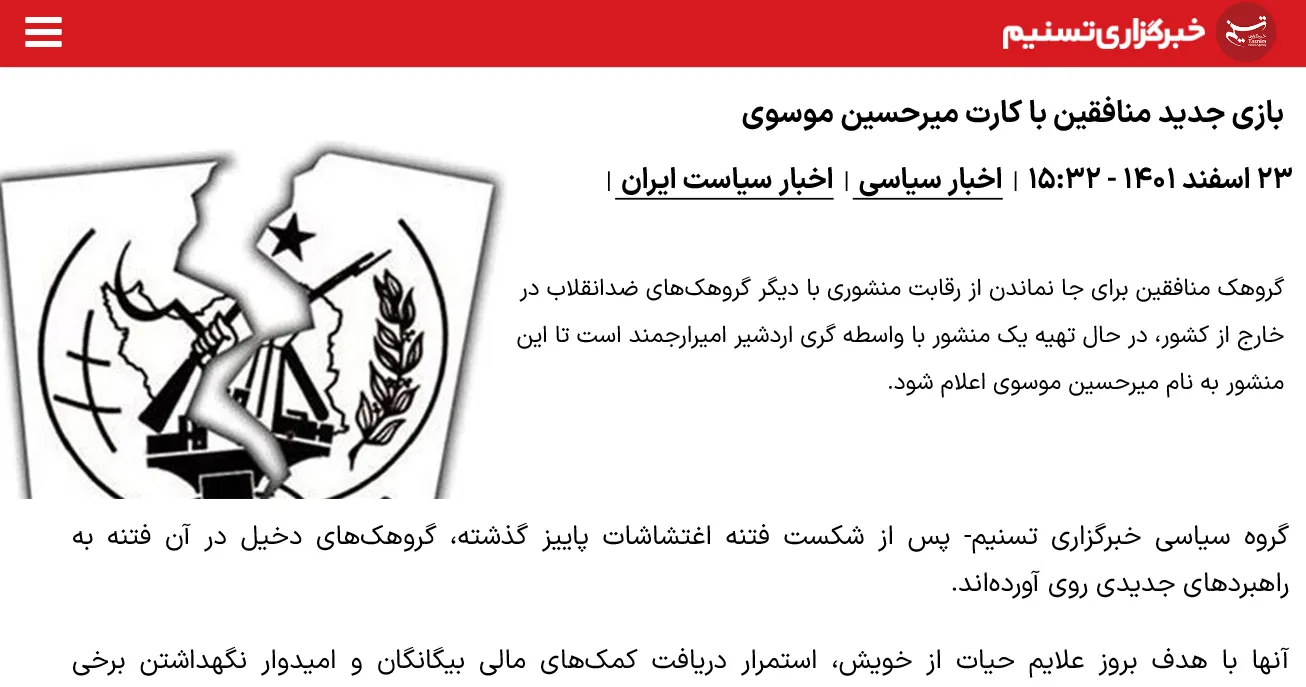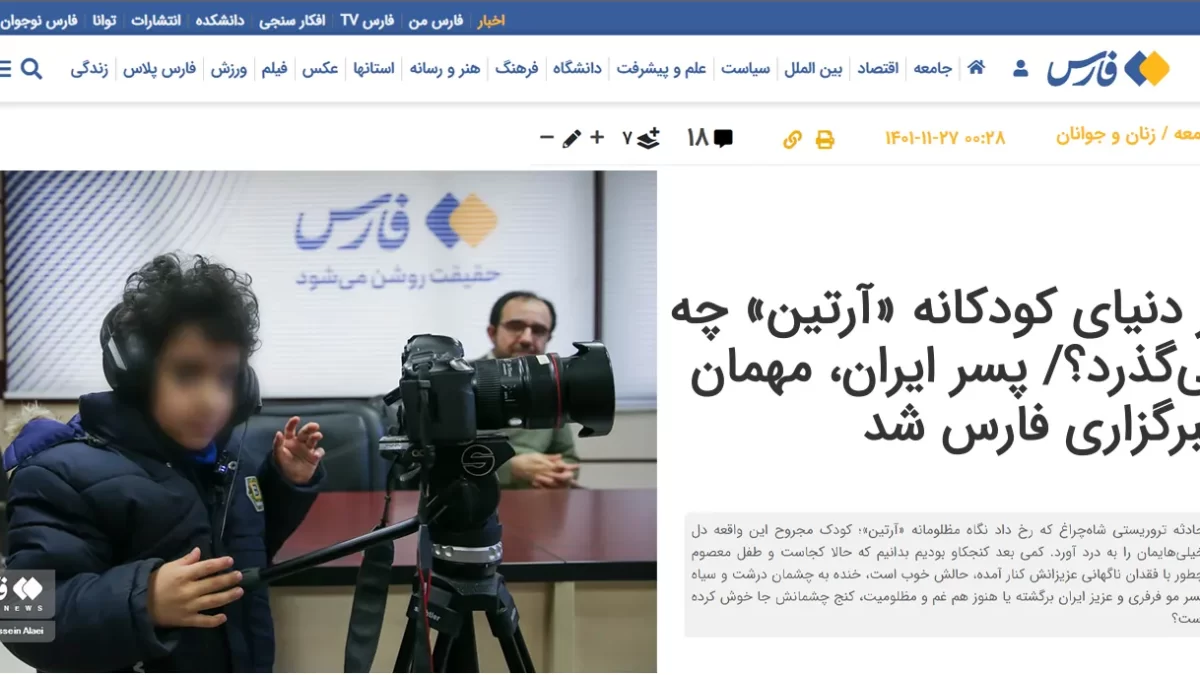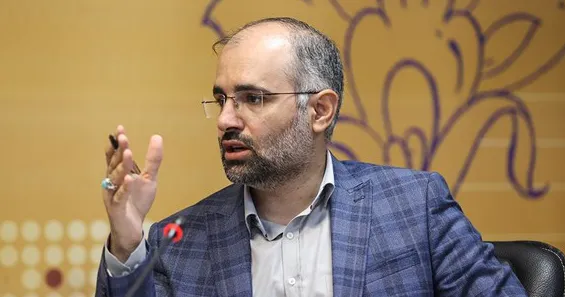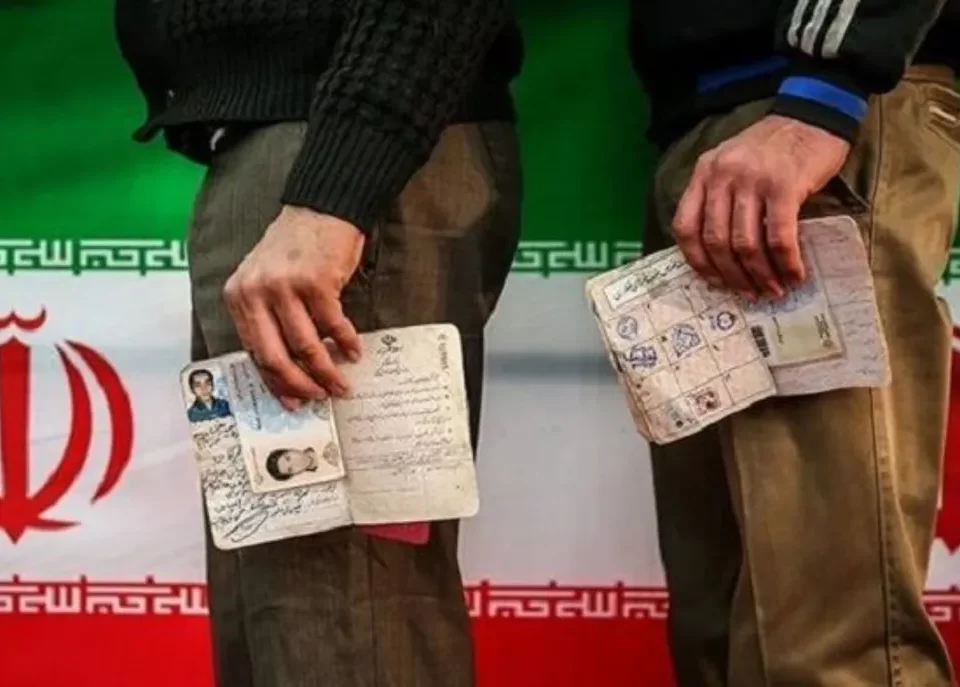
Media Review: Tasnim and the New Information Warfare Against Mir Hossein Mousavi
May 5, 2023
Media Review: Fars News Agency’s Disinformation for Supporting the Invader
May 5, 2023Media outlets select their subjects based on news values. “Frequency and prevalence of media coverage,” “the magnitude of the event,” “meaningfulness” (in cultural and social terms), “expectation,” “unpredictability,” and “uniqueness” are the values that drive media to cover an event or choose a subject. However, when it comes to children, the perspective should go beyond news values. It means that regardless of news values, children should be looked at independently, and in media coverage of children’s issues, their interests and well-being should be prioritized over news values.
However, contrary to children’s rights and the principles of children’s journalism, the media still views children as hot topics and exploits them to gain the attention of the audience, disregarding the best interests of children. Even some parents, without considering children’s rights, share videos and images of their children on social networks that contradict their interests.
On the 27th of Bahman 1401 (February 15, 2023), Fars News Agency published a report titled “What is Arteen going through in the world of children? / The Iranian boy becomes a guest of Fars News Agency,” focusing on a young boy who lost his father, mother, and brother in a terrorist attack on the Shah Cheragh Shrine in Shiraz.
The news agency invited “Arteen Saraydaran” to its editorial office and interviewed the child, referring to him as the “Iranian boy.”
This report exemplifies an unprofessional and inconsistent report violating the principles of children’s journalism, in which the privacy and interests of the child are disregarded, making him the subject of a report that can be criticized from various angles.
In this report, it is stated: “In a newsroom, there is a computer and a mobile phone; the very devices that when a child looks at them, they sit quietly in a corner, warming their head with computer games, and making their heart happy. But Arteen is not fond of sitting in one place. He does not show much curiosity for these devices. Even when you want to show him a children’s photo, game, or video on your mobile phone, he shows no interest and goes on to entertain himself in his own way. You say to yourself, ‘Mashallah, what a energetic child!’ There is no angle or corner that remains hidden from his perspective. He almost conquers all the floors of the news agency with his small and restless heartbeat, in a delightful conquest. He even knows where the last floor is and which part is there. Arteen loves driving, playing with trains, and drawing. The editorial team also tries not to leave him out.”
The news agency continues: “After the Maghrib call to prayer is broadcasted, accompanied by one of the provincial correspondents, he goes to the prayer room. Like a child, he performs a childlike worship, quickly and joyfully offers his humble prayers to God and then wants to recite the Quran. He pulls the microphone towards himself and becomes a Quran reciter, as he does in his own way. Now it’s his turn to catch fish from the blue-colored prayer room carpets. Suddenly, however, it seems as if the tomb of his father, mother, and brother comes to his mind, and he remembers death, grave, and cemetery. The little Quran reciter’s fishing, play, and childish mischief remain incomplete here.”
Fars News Agency, citing Arteen’s sister in the presence of Arteen himself, states: “Arteen is still sensitive to loud and sudden sounds. It was more prominent in the early days. Whenever a loud sound that he didn’t know where it came from occurred, his face would pale, and he would tell his sister Maryam, who is his only guardian and the only remnant of his mother and father, that he is being shot at and we are all going to die! The memory of the merciless Takfiri man with a gun in his hand trembling on his four-year-old body.”
Why is this report contrary to the principles of children’s journalism?
1- After the terrorist incident at the Shah Cheragh shrine, Arteen became unique, and this uniqueness is newsworthy. The audience wants to know about his fate, but journalists do not have the right to make him the subject of their reports and publish his images in various forms. Neither Arteen nor any other child should be the subject of media coverage. Media should focus on children’s issues, not on a specific child.
2- Bringing children to the media and publishing their images can endanger their safety. Therefore, the media are obliged to report on the overall situation of children in a personal manner instead of reporting on a specific child. It should not matter how much news value a child’s story has.
3- Just as children should not be shouted at, they should not be given attributes and titles. “Son of Iran” is an attribute that can change Arteen’s future, and it is unclear what benefit it would have for him. Giving titles to children can be a form of celebrity-making, an action that contradicts the interests of children. Media outlets are not allowed to turn childhood into a center of public attention.
4- The name and identity of the child should not be highlighted in media reports, especially when the child is a victim of a political scenario, a terrorist attack, or a war and conflict. This negligence can put the child at risk.
5- It is true that Arteen went to the Fars News Agency with his 20-year-old sister and her husband, who are currently taking care of him, and he must have been interviewed and his images published with their consent. However, this does not diminish the responsibility of the media. The media must pay attention to the impact of their reporting on the future of this child and refrain from entering into it. Publishing images of a child requires the consent of the child’s guardian, but when it is clear that the guardian is indifferent to the rights of the child under their care, even with their permission, the child’s image cannot be published in various frames.
6- Interviewing child victims of violence requires more sensitivity. Journalists are not allowed to put the child in a situation that re-traumatizes them. Any question or scene that revives the memory of the trauma for the child can put them in a vulnerable position. As Fars News Agency mentioned in this report, they took Arteen to the newsroom and revived the memory of his father, mother, and brother’s murder there.
7- Playing with the emotions of the audience is a well-known tactic of propaganda. Children can be the best subjects for playing with the emotions of the audience, but the media are not allowed to exploit children for political games and propaganda, as the ones who become victims are the children themselves. Children who become tools for playing with the emotions of the audience.
Artin is a victim and victims need support and protection, not media attention. Bringing a child victim to the office of a media outlet and exposing them to cameras and the sympathetic gazes of reporters present in the newsroom is not a kindness or service to this child; it is an injustice and a violation of ethical principles in journalism.
Avoiding the republication and sharing of this report, and refraining from liking it, is a way to counter the violation of children’s rights in the media. Paying attention to children’s rights is a collective responsibility, and all citizens are responsible for children and should respond sensitively to violations of their rights. Protesting against media outlets that violate children’s rights is the responsibility of the audience and advocates for children’s rights.
مرور رسانهها؛ خبرگزاری فارس و سلبریتیسازی غیراخلاقی از آرتین
رسانهها سوژههای خود را براساس ارزشهای خبری انتخاب میکنند. «کثرت وقوع و دایره فراگیری رسانه»، «وسعت حادثه»، «معناداری» (به لحاظ فرهنگی و اجتماعی)، «انتظار»، «غیرمنتظره بودن» و «خاص بودن» ارزشهایی هستند که رسانهها را به پوشش یک رویداد یا انتخاب یک سوژه وا میدارند. اما نگاه به کودکان باید فرای ارزشهای خبری باشد؛ یعنی مستقل از ارزشهای خبری باید به آنها نگاه کرد و در پوشش رسانهای مسایل کودکان، باید منفعت و مصلحت آنها در اولویت قرار گیرد، نه ارزشهای خبری.
اما برخلاف حقوق کودکان و اصول روزنامهنگاری کودک، رسانهها هنوز به کودکان به عنوان سوژههای داغ نگاه کرده و بیتوجه به منافع عالیه کودکان، از آنها برای جلب توجه مخاطبان استفاده میکنند. حتی برخی والدین در شبکههای اجتماعی با بیتوجهی به حقوق کودکان، ویدیو و تصاویری از فرزندانشان منتشر میکنند که در تضاد با منافع آنها است.
***
گزارش روز ۲۷ بهمن ۱۴۰۱ خبرگزاری «فارس» با عنوان «در دنیای کودکانه آرتین چه میگذرد؟ /پسر ایران میهمان خبرگزاری فارس شد»، به پسر بچهای پرداخته که پدر و مادر و برادر کودک خود را در حادثه تروریستی حرم شاهچراغ شیراز از دست داده است.
این خبرگزاری با دعوت از «آرتین سرایداران» به تحریریه خود، به گفتوگو با این کودک پرداخته و او را «پسر ایران» خوانده است.
این گزارش مصداق یک گزارش غیرحرفهای و مغایر اصول روزنامهنگاری کودک است که در آن ضمن بیتوجهی به حریم خصوصی و منافع این کودک، او را سوژه گزارشی کرده که از زوایای مختلف قابل نقد است.
در این گزارش آمده: «توی یک تحریریه خبری تا دلت بخواهد رایانه و تلفن همراه هست؛ همان لوازمی که وقتی بچهای نگاهش به آنها بیفتد، ساکت و آرام یک گوشه مینشیند و سرش را به بازیهای رایانهای گرم میکند و دلش را خوش. آرتین اما اهل یکجا نشستن نیست. کنجکاوی چندانی به این اقلام نشان نمیدهد. حتی وقتی میخواهی عکس، بازی یا فیلمی کودکانه در تلفن همراهت را به او نشان بدهی، رغبت نشان نمیدهد و میرود که به سبک خودش سرگرم و دلگرم شود. پیش خودت میگویی ماشاالله به این بچه، به این همه انرژی! زاویه و گوشهای نیست که از نظرش پنهان بماند. تقریباً تمام طبقات خبرگزاری را زیر پاهای کودکانه با تپش قلب کوچک و بیقرارش فتح میکند؛ فتحی دلنشین. حتی میداند که آخرین طبقه کجا است و کدام قسمت آنجا قرار دارد. آرتین رانندگی، قطاربازی و قلمدوش شدن را دوست دارد. خبرنگاران تحریریه هم سعی میکنند برایش کم نگذارند.»
این خبرگزاری در ادامه نوشته است: «بعد از این که اذان مغرب پخش میشود، همراه یکی از خبرنگاران گروه استانها خودش را به نمازخانه میرساند. بهرسم کودکی، عبادت کودکانه، بیوضو، سریع و دلنشینی به درگاه خدا هدیه میدهد و بعد هم میخواهد قرآن تلاوت کند و میکروفن را به سمت خودش میکشد و بهرسم خودش قاری قرآن میشود. حالا نوبت این است که از فرشهای آبیرنگ نمازخانه ماهی بگیرد. یکدفعه اما انگار که مزار پدر، مادر و برادرش در ذهنش تداعی شده باشند، یادی از مرگ، مزار و قبرستان میکند. ماهیگیری قاری کوچولو، بازی و شیطنت کودکانهاش اینجا ناتمام میماند.»
خبرگزاری فارس به نقل از خواهر آرتین و در حضور خودش میگوید: «آرتین هنوز هم به صداهای تقهدار و بلند حساس است. آن اوایل بیشتر. همینکه صدای بلندی که نمیدانست چیست و از کجا است، میآمد، رنگ از صورتش میپرید و به آبجی مریم که تنها یادگار مامان و بابا برای او و سرپرست آرتین است، میگفت که الآن شلیک میکند و همه ما میمیریم! خاطره مرد بیرحم تکفیری تفنگ به دست چهارستون بدنش را میلرزاند.»
چرا این گزارش مغایر اصول روزنامهنگاری کودک است؟
۱- آرتین پس از حادثه تروریستی حرم شاهچراغ، خاص شده و این خاص شدن، ارزش خبری است. مخاطب دوست دارد از سرنوشت او بداند ولی روزنامهنگار حق ندارد او را سوژه گزارش خود کرده و تصاویرش را در اشکال مختلف منتشر کند. اصولا نه آرتین، نه هیچ کودک دیگری نباید سوژه گزارش رسانهای شود. رسانهها باید به مسایل کودکان بپردازند، نه به کودکی خاص.
۲- آوردن کودکان به رسانهها و انتشار تصاویرشان میتواند امنیت آنها را به خطر اندازد. به همین دلیل، رسانهها مکلف هستند به جای گزارش در مورد یک کودک، به گونه فردی، از وضعیت کودکان به طور کلی گزارش تهیه کنند. نباید مهم باشد که داستان یک کودک چهقدر ارزش خبری دارد.
۳- همانطور که نباید به کودکان انگ زد، صفت و القاب هم نباید به کودکان داد. پسر ایران صفتی است که میتواند آینده آرتین را دستخوش تغییر و تحول کند؛ تغییری که روشن نیست برای او منفعتی در پی داشته باشد. القاب دادن به کودکان میتواند نوعی سلبریتی سازی باشد؛ اقدامی که در تضاد با منافع کودکان است. رسانهها مجاز نیستند کودکی را به کانون توجه عموم تبدیل کنند.
۴- نام و هویت کودک نباید در گزارش رسانهها مورد توجه قرار گیرد، خصوصا وقتی کودکی قربانی یک سناریو سیاسی یا یک حمله تروریستی یا یک جنگ و درگیری است. این بیتوجهی میتواند کودک را در معرض خطر قرار دهد.
۵- درست است که آرتین با خواهر ۲۰ ساله و شوهر خواهرش که این این روزها سرپرستی او را برعهده دارند، به خبرگزاری فارس رفته و حتما با رضایت آنها با آرتین مصاحبه و تصاویر او منتشر شده است ولی این از مسوولیت رسانه کم نمیکند. رسانه باید به تاثیر گزارش خود بر آینده این کودک توجه کند و از ورود به آن بپرهیزد. انتشار تصاویر کودک نیازمند رضایت سرپرست کودک است ولی وقتی روشن است که سرپرست کودک نسبت به حقوق کودک تحت سرپرستی خود بیتفاوت است، حتی با اجازه آنها نمیتوان تصویر کودک را در قابهای مختلف منتشر کرد.
۶- مصاحبه با کودکان قربانی خشونت نیازمند حساسیت بیشتر است. خبرنگار مجاز نیست کودک را در موقعیت آسیب مجدد قرار دهد. هر پرسشی و هر صحنهآرایی که خاطره آسیب را برای کودک زنده کند، میتواند او را در موقعیت آسیب مجدد قرار دهد؛ همانگونه که خبرگزاری فارس در این گزارش آورده است که آنها آرتین را به نمازخانه خبرگزاری برده و آنجا خاطره قتل پدر و مادر و برادرش را زنده کردهاند.
۷- بازی با احساسات مخاطبان، یکی از تاکتیکهای شناخته شده پروپاگاندا است. کودکان میتوانند بهترین سوژهها برای بازی با احساسات مخاطبان باشند ولی رسانهها مجاز به سوءاستفاده از کودکان برای بازیهای سیاسی و پروپاگاندا نیستند، زیرا کسانی که در این میان قربانی میشوند، کودکان هستند؛ کودکانی که به ابزاری برای بازی با احساسات مخاطبان تبدیل میشوند.
آرتین یک قربانی است و قربانی نیاز به حمایت و محافظت دارد، نه جلب توجه رسانهای. آوردن یک کودک قربانی به تحریریه یک رسانه و نشاندن او در برابر دوربین عکاسان و نگاههای ترحمآمیز خبرنگاران حاضر در تحریریه، لطف و خدمت به این کودک نیست، ظلم و مغایر اصول اخلاق روزنامهنگاری است.
پرهیز از بازنشر و به اشتراک گذاشتن این گزارش و لایک نکردن آن، راه مقابله با نقض حقوق کودکان در رسانهها است. توجه به حقوق کودکان یک مسوولیت جمعی است و همه شهروندان در برابر کودکان مسوول هستند و باید نسبت به نقض حقوق کودکان با حساسیت برخورد کنند. برخورد اعتراضی با رسانههای ناقض حقوق کودکان، مسوولیت مخاطبان و مدافعان حقوق کودکان است.




